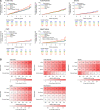Nighttime Blood Pressure Phenotype and Cardiovascular Prognosis: Practitioner-Based Nationwide JAMP Study
- PMID: 33131317
- PMCID: PMC7643792
- DOI: 10.1161/CIRCULATIONAHA.120.049730
Nighttime Blood Pressure Phenotype and Cardiovascular Prognosis: Practitioner-Based Nationwide JAMP Study
Erratum in
-
Correction to: Nighttime Blood Pressure Phenotype and Cardiovascular Prognosis: Practitioner-Based Nationwide JAMP Study.Circulation. 2020 Dec 22;142(25):e632. doi: 10.1161/CIR.0000000000000944. Epub 2020 Dec 21. Circulation. 2020. PMID: 33347334 Free PMC article. No abstract available.
Abstract
Background: Ambulatory and home blood pressure (BP) monitoring parameters are better predictors of cardiovascular events than are office BP monitoring parameters, but there is a lack of robust data and little information on heart failure (HF) risk. The JAMP study (Japan Ambulatory Blood Pressure Monitoring Prospective) used the same ambulatory BP monitoring device, measurement schedule, and diary-based approach to data processing across all study centers and determined the association between both nocturnal hypertension and nighttime BP dipping patterns and the occurrence of cardiovascular events, including HF, in patients with hypertension.
Methods: This practitioner-based, nationwide, multicenter, prospective, observational study included patients with at least 1 cardiovascular risk factor, mostly hypertension, and free of symptomatic cardiovascular disease at baseline. All patients underwent 24-hour ambulatory BP monitoring at baseline. Patients were followed annually to determine the occurrence of primary end point cardiovascular events (atherosclerotic cardiovascular disease and HF).
Results: A total of 6,359 patients (68.6±11.7 years of age, 48% men) were included in the final analysis. During a mean±SD follow-up of 4.5±2.4 years, there were 306 cardiovascular events (119 stroke, 99 coronary artery disease, 88 HF). Nighttime systolic BP was significantly associated with the risk of atherosclerotic cardiovascular disease and HF (hazard ratio adjusted for demographic and clinical risk factors per 20-mm Hg increase: 1.18 [95% CI, 1.02-1.37], P=0.029; and 1.25 [95% CI, 1.00-1.55], P=0.048, respectively). Disrupted circadian BP rhythm (riser pattern, nighttime BP higher than daytime BP) was significantly associated with higher overall cardiovascular disease risk (1.48 [95% CI, 1.05-2.08]; P=0.024), and especially HF (2.45 [95% CI, 1.34-4.48]; P=0.004) compared with normal circadian rhythm.
Conclusions: Nighttime BP levels and a riser pattern were independently associated with the total cardiovascular event rate, in particular for HF. These findings suggest the importance of antihypertensive strategies targeting nighttime systolic BP. Registration: URL: https://www.umin.ac.jp/ctr/; Unique identifier: UMIN000020377.
Keywords: cardiovascular disease; diurnal blood pressure variability; heart failure; nighttime blood pressure; nocturnal hypertension.
Conflict of interest statement
K.K. has received research funding from Omron Healthcare Co, Fukuda Denshi, and A&D Co. The other authors report no conflicts.
Figures


Comment in
-
Letter by Pengo et al Regarding Article, "Nighttime Blood Pressure Phenotype and Cardiovascular Prognosis: Practitioner-Based Nationwide JAMP Study".Circulation. 2021 May 25;143(21):e980-e981. doi: 10.1161/CIRCULATIONAHA.120.052728. Epub 2021 May 24. Circulation. 2021. PMID: 34029135 No abstract available.
-
Response by Kario et al to Letter Regarding Article, "Nighttime Blood Pressure Phenotype and Cardiovascular Prognosis: Practitioner-Based Nationwide JAMP Study".Circulation. 2021 May 25;143(21):e982-e983. doi: 10.1161/CIRCULATIONAHA.121.053993. Epub 2021 May 24. Circulation. 2021. PMID: 34029139 No abstract available.
References
-
- Umemura S, Arima H, Arima S, Asayama K, Dohi Y, Hirooka Y, Horio T, Hoshide S, Ikeda S, Ishimitsu T, et al. The Japanese Society of Hypertension guidelines for the management of hypertension (JSH 2019). Hypertens Res. 2019;42:1235–1481. doi: 10.1038/s41440-019-0284-9 - PubMed
-
- Whelton PK, Carey RM, Aronow WS, Casey DE, Jr, Collins KJ, Dennison Himmelfarb C, DePalma SM, Gidding S, Jamerson KA, Jones DW, et al. 2017 ACC/AHA/AAPA/ABC/ACPM/AGS/APhA/ASH/ASPC/NMA/PCNA guideline for the prevention, detection, evaluation, and management of high blood pressure in adults: executive summary: a report of the American College of Cardiology/American Heart Association Task Force on Clinical Practice Guidelines. Circulation. 2018;138:e426–e483. doi: 10.1161/CIR.0000000000000597 - PubMed
-
- Williams B, Mancia G, Spiering W, Agabiti Rosei E, Azizi M, Burnier M, Clement DL, Coca A, de Simone G, Dominiczak A, et al. ; ESC Scientific Document Group. 2018 ESC/ESH guidelines for the management of arterial hypertension. Eur Heart J. 2018;39:3021–3104. doi: 10.1093/eurheartj/ehy339 - PubMed
-
- Kario K, Thijs L, Staessen JA. Blood pressure measurement and treatment decisions. Circ Res. 2019;124:990–1008. doi: 10.1161/CIRCRESAHA.118.313219 - PubMed
-
- Ruilope LM, Ruiz-Hurtado G, Barderas MG, de la Cruz JJ, Lucia A, de la Sierra A, Gorostidi M, Vinyoles E, Segura J, Solís J, et al. Frequency and prognosis of treated hypertensive patients according to prior and new blood pressure goals. Hypertension. 2019;74:130–136. doi: 10.1161/HYPERTENSIONAHA.119.12921 - PubMed
Publication types
MeSH terms
Associated data
- Actions
LinkOut - more resources
Full Text Sources
Other Literature Sources
Medical
Research Materials
Miscellaneous

